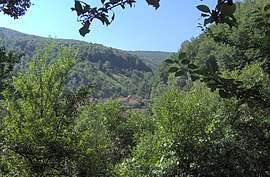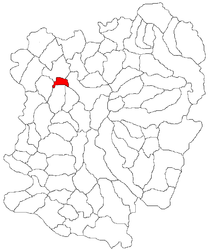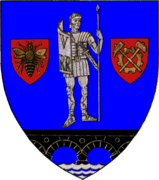Ocna de Fier
Ocna de Fier (Hungarian: Vaskő, German: Eisenstein) is a commune in Caraș-Severin County, in the Banat region of southwestern Romania. It is composed of a single village, Ocna de Fier.
Ocna de Fier | |
|---|---|
 | |
 Location in Caraș-Severin County | |
 Ocna de Fier Location in Romania | |
| Coordinates: 45°20′N 21°47′E | |
| Country | |
| County | Caraș-Severin |
| Population (2011)[1] | 656 |
| Time zone | EET/EEST (UTC+2/+3) |
| Vehicle reg. | CS |
History
Along with the Dognecea area, Ocna de Fier is among the few settlements in the world that supported almost continuous mining for some 4000 years.[2]
Archaeological evidence shows that mining in the area dates back to the Bronze Age (1900 - 1700 BC). The main ore exploited in those times was native copper from the oxidation zone of the deposit. Later on, iron ores brought about a gradual switch from copper to iron mining.
Mining was an activity of the Dacians, the ancient inhabitants of present-day Romania. After the Roman conquest in 106, mining was expanded in the Roman province of Dacia. At Berzovis (present day Berzovia, ten kilometres northwest of Ocna de Fier) a Roman metallurgy school, Schola fabrorum, was established, showing the keen interest the Romans had in metal extraction. At Cracul cu Aur (Romanian for "Golden Tributary"), north of Ocna de Fier, old Roman gold mining galleries can still be seen. They look like the much better preserved ones at Rosia Montana ("Verespatak"), in the Apuseni Mountains.
The Constantin Gruescu Iron Aesthetic Mineralogy Museum is located in Ocna de Fier.[3]
References
- "Populaţia stabilă pe judeţe, municipii, oraşe şi localităti componenete la RPL_2011" (in Romanian). National Institute of Statistics. Retrieved 4 February 2014.
- "Age and tectonic setting of Bocşa and Ocna de Fier – Dognecea", Mineralium Deposita, 1999
- Museum Information
